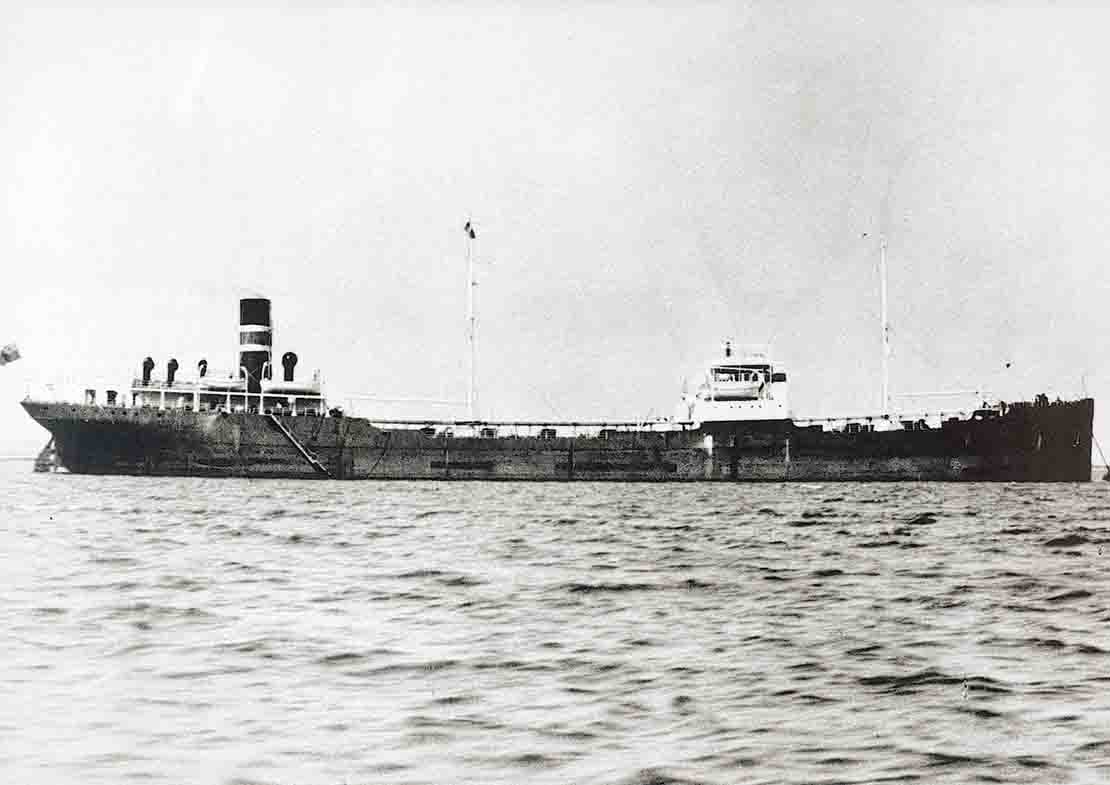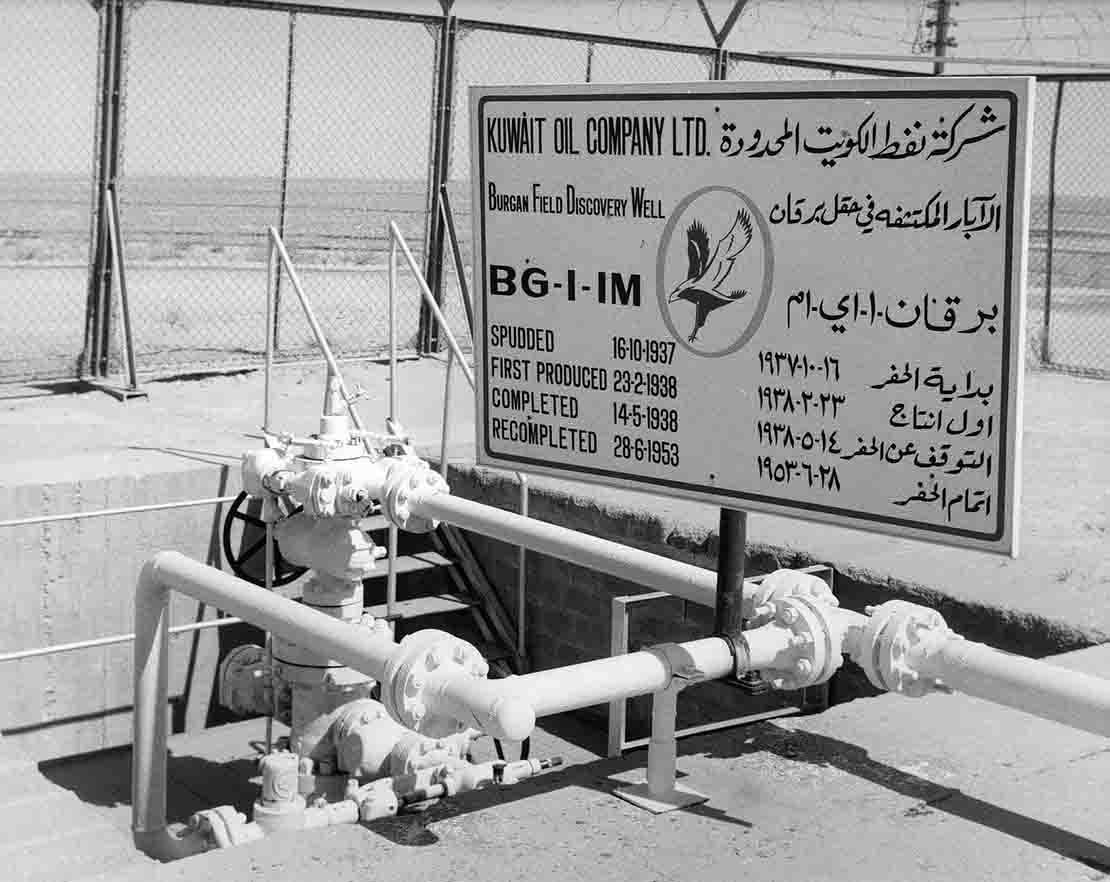1930s
|
1934 |
Kuwait Oil Company (KOC) is established by British Petroleum (BP) and Gulf Oil Corporation, now known as Chevron. H.H. Sheikh Ahmad Al-Jaber Al-Sabah (1885–1950), the ruler of Kuwait from 1921 to 1950, signs Kuwait’s oil concession agreement. KOC is incorporated in London with an initial capitalization of GBP 50,000. |
| 1936 |
The first oil concession is granted by Sheikh Ahmad Al-Jaber Al-Sabah. First drilling rig used in Kuwait—Bahra, North Kuwait; KOC drills a hole to 7,950 ft, but it is dry. KOC begins geophysical survey. H.H. Sheikh Ahmad Al-Jaber Al-Sabah visits the site of Kuwait’s first oil well in Burgan. |
| 1937 | Burgan Field Discovery Well, BG-I-IM, is spudded; it is the first oil well in Kuwait. |
| 1938 |
BG-I-IM's first production, commercial quantities. At the time, Burgan was the world’s largest oil field and today is still the second largest field ever discovered (after Ghawar in Saudi Arabia). |
| 1939 | Schlumberger runs the first well log in Kuwait, on well Burgan 3. |
1940s
| 1946 | With the discovery of oil there, Al Ahmadi is founded, a city in the eponymous region in the south of the country; the city and region are named after Sheikh Ahmad Al-Jaber. His Highness Sheikh Ahmad Al-Jaber Al-Sabah, the late Amir of Kuwait, inaugurates the export of Kuwait’s first crude oil shipment; the tanker British Fusilier transports the oil. |
1950s
| 1950 | Ahmadi Airport opens in the Dasma area, just south of what is now Kuwait City. The airport is a significant extension of the first airfield built there in 1927. The first flights then were operated by Empire Airlines, which later became British Airways. It used the land runway in Dasma as fuel platform for its flights from Britain to India and back again. |
| 1954 | Kuwait National Airways Company is established. |
| 1956 | Kuwait becomes the leading oil exporter in the region, a position it held for a decade. |
| 1957 | New KOC main office building, Ahmadi. |
| 1959 | First Kuwaiti tanker for crude oil is built, the Kazimah—49,000 tonUK. |
1960s
| 1960 | Ahmadi Hospital is inaugurated by KOC and was called then “Southwell Hospital” after Sir Philip Southwell, who was KOC President from 1946 to 1959. During the 1980s, the name was changed to “Ahmadi Hospital.” |
| 1961 | The signing by the Amir, the late Sheikh Abdulla Al-Salem Al-Sabah, the 11th ruler of Kuwait, is named as the “father of independence” of the independence treaty with Sir George Middleton, the British commissioner for the Arabian Gulf, on behalf of his government. |
| 1966 | H.H. Sheikh Sabah Al-Salem Al-Sabah lays the cornerstone of Sabahiya City. Schlumberger runs thermal neutron decay tools in KOC wells for measurement of water saturation. |
1970s
| 1971 | KOC’s Gas Project: natural gas naturalization following pressure from the Kuwaiti Parliament aiming at a reduction of gas flaring; from 1971 onward, natural gas is employed as a domestic feedstock in different activities. |
| 1975 | The Kuwaiti government takes 100% control of KOC. |
1980s
| 1980 | The Kuwait Petroleum Corporation (KPC) is established to bring all state-owned oil companies under one entity. The KPC holds a number of companies, including KOC for domestic upstream operations and Kuwait National Petroleum Company (KNPC) for domestic downstream operations. |
| Mid-1980s | First use of ESPs in Kuwait, provided by Schlumberger. |
1990s
| 1996 | Fiftieth anniversary of first oil shipment. |
| 1997 | Schlumberger tests and uses nuclear magnetic resonance (NMR) well logging to better define effective reservoir porosity in KOC wells in West Kuwait carbonate reservoirs. |
| 1998 | KOC forms an agreement with Schlumberger to implement a secure corporate database system for its core business data, a state-of-the-art integrated data management system. |
2000s
| 2002 | H.H. Sheikh Sabah Al-Ahmad Al-Sabah inaugurates the new oil pier at Mina Al-Ahmadi. Schlumberger VDA viscoelastic diverting acid for stimulation jobs is first used in the northern Kuwait Sabriya field, which is operated by KOC. |
| 2005 | Superlight crude oil is discovered at the Sabriya Field. The discovery of the 52-API crude oil represents a great leap forward for the company’s exploration abilities. KOC works with Schlumberger to provide employees with fast access to its corporate E&P databases; Schlumberger creates the KOC GeoPortal, a secure Web portal that provides a framework and workspace for 1,500 KOC users. The Oil Export Facilities Development project is launched at a total cost of KWD 360.5 million [USD 1.35 billion]; the project includes the 19 large reservoirs in the northern and southern hangars, an extension of 5 pumping tubes functioning by terrestrial gravity in the northern hangar, and the installation of 5 marine oil lines of varying sizes. New oil pier. In recognizing a need for increasing domestic supply of natural gas, KOC gives Schlumberger the chance to help it develop the first nonassociated gas field in Kuwait. |
| 2006 | Gas is discovered in the deep Jurassic reservoirs at Rahiya, Mutriba, Um Niga, and other fields throughout Kuwait. These discoveries fulfill a long-standing Kuwaiti dream of becoming self-sufficient in gas that can be used for power generation. |
| 2008 | Working with Schlumberger, KOC uses a combination of openhole packers, frac ports, and chemicals to revive a horizontal oil producer in the Sabriya field, where production had dropped to zero shortly after the well was completed in 2004. |
| 2009 |
Working with KOC, Schlumberger uses local grid refinement (LGR) to combine basin- and reservoir-scale models. Though LGR is well established in reservoir simulators, this is the first use in 3D fluid-migration simulation. Schlumberger is awarded several service contracts (4+1 years) for KOC; the contracts include MWD/LWD, directional drilling services, coiled tubing/pumping services, surface well testing, and slickline services. These and previous contracts position Schlumberger as the primary service company in terms of helping KOC to achieve Kuwait's 2030 target of 4 million bbl/d. |
2010s
| 2010 | Opening of the Dar Schlumberger base. Schlumberger’s North Kuwait Jurassic Gas KwIDF (Kuwait Integrated Digital Field) becomes operational; it is an excellent example of early value realization from digital oilfield concepts being applied to greenfields from inception. To obtain more detailed information about the fractures in the carbonate reservoirs of Kuwait, KOC acquired a state-of-the-art 3D seismic survey pilot survey over 100 km2 of the Northwest Raudhatain field using WesternGeco Q-Land technology. Schlumberger helps KOC characterize shallow complexity of a target formation in a near-surface zone. |
| 2011 | KOC successfully achieves its goal of reducing gas flaring to approximately 1%. Compared with gas flaring levels of as high as 17% just a few years earlier, this represents a major accomplishment for KOC. The Schlumberger Kuwait GeoMarket (KWT) is established as a separate entity in the Middle East Area (MEA). |
| 2014 | Schlumberger Kuwait has grown to more than 1,100 employees representing more than 30 nationalities and supported by 15 different business segments. KOC awards WesternGeco a 5-year contract for a 3D high-resolution, full-azimuth 4,200-km2 survey over the Greater Burgan and Khabrat Ali Fields using several integrated geophysical technologies; the survey, which included both acquisition and data processing, will be conducted using the UniQ integrated point-receiver land seismic system with over 200,000 channels, making this one of the world’s largest land seismic surveys in terms of channel count. Opening of the Real-Time Drilling Decision Center (RTDDC) in Kuwait; the purpose of the RTDDC is to provide KOC drilling teams and remote engineers with high-technology facilities to monitor the drilling program in real time. |




